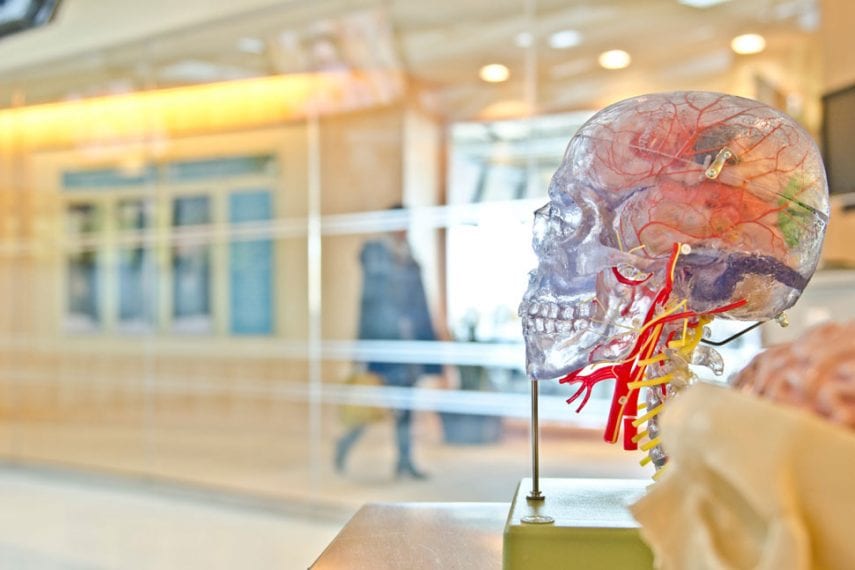An Elusive Circuitry: The Promise and Limits of Biological Psychiatry in the Treatment of Mental Illness

Part 1
I’m sitting in a chair covered in what I assume is vinyl. It looks kind of like a dentist’s chair. I wonder why they don’t use leather, it seems like it would be more durable. But maybe vinyl is easier to clean and disinfect? That’s probably it. Hospitals need to disinfect things. I don’t think you can spray Lysol on leather.
I’ve never before considered a chair as intently as this, but I’m in pain and I need to not think about it. On my forehead is a butterfly-shaped coil transmitting high-frequency electromagnetic pulses to my frontal lobe every ten seconds for five minutes, and even the four Aleve I took in my car before my appointment isn’t enough to dampen stings that feel like rubber bands snapping on my forehead. Five minutes feels like a very long time when you’re measuring it in units of pain. I focus on my breathing, I focus on the chair, and I focus on the promise of rTMS.
Better Living Through Biological Psychiatry
rTMS, or repetitive transcranial magnetic stimulation, is part of a new generation of biologically-focused mental health therapies that seek to address psychiatric illness via targeted brain circuit interventions. The concept of using direct brain stimulation to treat mental illness is not new; both clinically sound therapies like electroconvulsive therapy (ECT) and barbaric practices like lobotomies have identified neural activity as the locus of mental illness, and sought to disrupt maladaptive brain activity by manipulating cerebral tissue. Recent advances in neuroscience and neuroimaging, however, have greatly augmented our understanding of brain functions and allowed researchers to begin mapping the neurons and circuits implicated in certain types of mental health disorders. This reinvigorated interest in biological psychiatry marks a sharp departure from the focus on brain chemistry and lived experiences that has dominated psychiatry for decades.
Begin Your Recovery Journey.
877-727-4343Part 2
Every weekday for five weeks I drive to the hospital and fill out a series of depression and anxiety inventories to track my progress. Am I so sad or unhappy I cannot stand it? Do I feel like a failure? Do I hate myself? Would I kill myself if I had the chance? I guess it depends on the time of day, but I pick an answer, wait to be called into the treatment room with the sticky vinyl chair, and brace for the sting.
When each session is over I feel dazed. I feel calm. I feel maybe happy. I don’t know if it’s the result of rTMS, the painkillers and deep breathing, or the fact that I have taken five weeks off work to accommodate the intensive treatment schedule rTMS requires. I choose to believe it is the rTMS, but every morning when I ask myself if I want to kill myself or if I’m so sad I can’t stand it a small part of me still says yes.
Separating Symptoms from Causes
One of the most frustrating parts about mental illness has long been the subjectivity and imprecision of both diagnosis and treatment. Unlike most physical illnesses, there are no telltale biomarkers for mental health disorders, no blood tests, no swabs, no x-rays. In fact, the causes of mental health disorders and what exactly they do to the brain is largely a mystery. As such, treatment itself is an imprecise science; if mental illnesses are disorders of the brain and the brain remains an elusive creature, how can we know that we are treating the disorder and not simply the symptoms? That is the conundrum that biological psychiatry seeks to address.
“Cancer treatment doesn’t treat the symptoms of cancer. You don’t want the swelling to go down or the pain to disappear; you want to get rid of the cancer,” says Kenneth Kaitin, director of the Tufts University Center for the Study of Drug Development. “But that’s what we’re doing in psychiatry,” treating symptoms rather than causes. Proponents of brain-focused treatments believe that disrupting malfunctioning neuronal activity and strengthening or weakening specific circuits implicated in mood regulation is the way forward.
Hasan Asif is one of those proponents. A trained psychoanalyst, he now uses quantitative electroencephalographs (qEEG) to map his patients’ brains and identify areas of abnormal activity. Using video-assisted neurofeedback, he trains the patient’s brain to restore healthy function based on visual sensory responses; the patient watches “a pleasant nature movie during which the patient’s brain activity is automatically compared every half-second to the goal.” If the brain is behaving normally, the movie keeps playing. If the brain behaves abnormally, it stops. The continuation of the film acts as a carrot to lead the brain toward healthy activity. For some, the results are transformative. “It was like being reborn,” says one woman who suffered from severe depression and paranoia prior to treatment.
Part 3
Over the course of my five weeks of treatment, I keep expecting a transformation. During my initial consultation with the psychiatrist who oversees the rTMS study I’m a part of, he tells me that either the treatment works or it doesn’t; he rarely sees patients who get halfway better. Despite the enduring depressive episode that got me a place in the study, my hope runs eternal; I never score higher than a one on Question Two of the Beck Depression Inventory, the one that asks if you feel hopeless about the future. Every time I sit in my car swallowing my painkillers, I think, “Maybe today will be the day.” But as the weeks pass, no such transformation comes. Despite the fact that I try to convince myself that the short calmness immediately following each treatment is a sign of progress and tell the technician that I think it might be working, I know that it isn’t true. By the time my exit interview comes around, I am too depressed to leave the house. I skip it and feel guilty for weeks. In my head I circle a three on Question Five of the Beck Depression Inventory: I feel guilty all of the time.
Dissent and Disturbance
Not everyone in the mental health field believes that biological psychiatry is the way forward. “As a psychiatrist and psychopharmacologist who loves neuroscience, I find this trend very disturbing,” says Dr. Richard A. Friedman.
Even if [mental illnesses are solely diseases of the brain] — and many would consider it reductionist and simplistic — an undertaking as ambitious as unraveling the function of the brain would most likely take many years. Moreover, a complete understanding of neurobiology is unlikely to elucidate the complex interactions between genes and the environment that lie at the heart of many mental disorders. Sure, we now have astounding new techniques for studying the brain, like optogenetics, in which neurons can be controlled by light, allowing researchers to understand how neurons work alone and in networks. But no one thinks breakthrough biological treatments are just around the corner.
Despite the tremendous growth in our understanding of how the brain functions, we are still only in the beginning stages of truly knowing how the brain behaves and how to manipulate it to behave differently. In fact, there is currently widespread debate about exactly which area of the brain should be targeted during rTMS. “We still have a lot to learn about how and why these brain stimulation methods work,” Chris Chambers of Cardiff University tells The Guardian. “It’s like driving a car with your eyes closed; you might get lucky and survive and you might even arrive somewhere great. But damned if you know how you got there.”
Many believe that an exclusive focus on brain behavior and the move away from psychotherapy misses many of the essential pieces of the psychological puzzle, including a recognition of the ways trauma, culture, social location, and interpersonal relationships can impact mental health. “Many of our patients have histories of trauma, sexual abuse, the stress of poverty or deprivation,” Dr. Friedman says. “There is obviously no quick biological fix for these complex problems.” Dr. Sidney J. Blatt, psychologist and professor emeritus of psychiatrist at Yale University, believes that biological psychiatry also fails to acknowledge the nuanced and reciprocal relationship between biology and lived experience:
Research evidence indicates that these biological and genetic factors can be actuated, impeded or even transformed by interpersonal experiences throughout life, beginning in infancy. Constructive interpersonal experiences, as can occur in psychotherapy, are also important factors in understanding the etiology and treatment of mental illness.
In fact, lived experiences are not separate from our brains, but simultaneously produce and are produced by neural activity and circuitry. Treatment modalities that ignore the experiential factors involved in mental illness not only fail to address the full scope of treatment needs, but may also be limiting the true possibilities of neural change. Evidence is clear that psychotherapy and holistic therapeutic modalities can modulate brain activity and even regenerate gray matter while simultaneously giving people suffering from mental illness the insight and skills to engage in profound healing, emotional and behavioral change, and personal growth. As such, comprehensive mental health treatment that draws on multiple, evidence-based approaches that speak to each person’s unique symptoms and circumstances can bring a depth and breadth of treatment that a singular focus technology-driven brain stimulation cannot. While these new treatment modalities may be a valuable part of treatment, for most, they are unlikely to be the only part.
Call for a Free Confidential Assessment.
877-727-4343Part 4
I do not regret my rTMS treatment. While it did not draw me out of my depressive episode, I met people for whom it was transformative and even life-saving, people who had tried everything and finally found solace through 625 minutes of electromagnetic stimulation. Bearing witness to their successes was powerful and affirming. But the brain is a delicate structure that still lurks mostly in shadow, and therapeutic brain stimulation is in its infancy. Ultimately, neuroscience may give us new pathways towards recovery and pave the way for wellness in those for whom traditional treatments have been unsuccessful. For some, it is already doing so. At the same time, these new treatment technologies exist within very real and meaningful limits, many of which remain unknown. What we do know is that brain stimulation does not teach you how to live in the world. It doesn’t make your rape okay or erase your abusive partner. It doesn’t teach you how give and receive love or create a purposeful life. It doesn’t show you how to forgive or mend your relationships with others. And while biological psychiatry doesn’t claim to do any of those things, ignoring the need for them also ignores the full reality of mental illness.
The brain is a remarkable instrument in part because it is more than the sum of its parts; it is something unquantifiable and infinitely complex that goes beyond biology and becomes humanity, a slippery and extraordinary thing.
Bridges to Recovery offers comprehensive residential treatment for people living with mental health disorders as well as co-occurring substance abuse and process addictions. Contact us to learn more about our innovative program, a curriculum of modern, evidence-based therapies, and how we can help you or your loved one on the path to healing.






